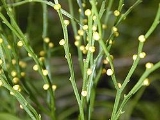
Psilotopsida
Encyclopedia
Psilotopsida is a class of fern
-like plants. It should not be confused with the obsolete class Psilophytopsida
. As circumscribed by Smith et al. (2006) Psilotopsida contains two families, Psilotaceae
and Ophioglossaceae
, placed in orders Psilotales and Ophioglossales
, respectively. The affinities of these two groups have long been unclear and a close relationship between them has only recently been confirmed through molecular systematic studies. Psilotopsida is the sister-group to all other ferns (including Marattiaceae and Equisetaceae
).
Fern
A fern is any one of a group of about 12,000 species of plants belonging to the botanical group known as Pteridophyta. Unlike mosses, they have xylem and phloem . They have stems, leaves, and roots like other vascular plants...
-like plants. It should not be confused with the obsolete class Psilophytopsida
Psilophytopsida
Psilophytopsida is a now obsolete class containing one order, Psilophytales, which was previously used to classify a number of extinct plants which are now placed elsewhere...
. As circumscribed by Smith et al. (2006) Psilotopsida contains two families, Psilotaceae
Psilotaceae
Psilotaceae is a family of fern-like plants consisting of two genera, Psilotum and Tmesipteris. The two genera are very different and in the past Tmesipteris has been placed in its own family, Tmesipteridaceae, but most classifications continue to treat it in Psilotaceae...
and Ophioglossaceae
Ophioglossaceae
Ophioglossaceae, the Adder's tongue family, is a family of ferns, currently thought to be most closely related to Psilotaceae, the two together comprising the class Psilotopsida as the sibling group to the rest of the ferns. The Ophioglossaceae is one of two groups of ferns traditionally known as...
, placed in orders Psilotales and Ophioglossales
Ophioglossales
Ophioglossales are a small group of pteridophyte plants. Traditionally they are included in the division Pteridophyta, the ferns, originally as a family and later as the order Ophioglossales...
, respectively. The affinities of these two groups have long been unclear and a close relationship between them has only recently been confirmed through molecular systematic studies. Psilotopsida is the sister-group to all other ferns (including Marattiaceae and Equisetaceae
Equisetaceae
Equisetaceae, sometimes called the horsetail family, is the only extant family of the class Equisetales, with one surviving genus, Equisetum, which comprises about twenty species.- Evolution and systematics :...
).

